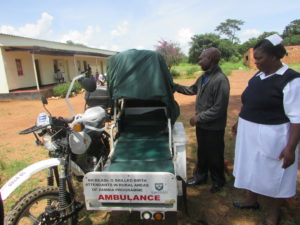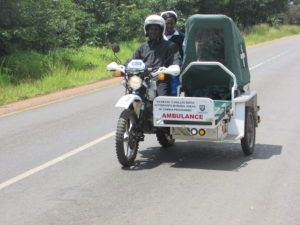Women in Zambia face a lifetime risk of 1 in 100 of dying in pregnancy or childbirth, and 1 in 37 infants die in their first month of life. Many of these deaths are a result of delay in seeking care.
While many women know to go to a health facility to improve their chances of a safe childbirth, getting there can be a significant challenge. Reaching one of these facilities often requires travel over long distances without transportation, or on roads that are in poor condition.
A partnership between the Swedish Embassy, the Zambian government, and the Clinton Health Access Initiative (CHAI) is strengthening access to quality care for mothers and babies.
Working across 14 districts in three provinces, this initiative has helped improve the skills of 221 health workers deployed in rural and remote parts of Zambia through training and mentorships in the area of Emergency Obstetric and Newborn care. It has helped link communities to health centers through improved communication and it is improving transport to health facilities through the usage of motorbike ambulances, enabling women to quickly access lifesaving care.
Prior to this arrangement, women would rely on ox-carts and bicycles as modes of transportation to the local health facility, while those who couldn’t afford these options would walk. Since the introduction of motorbike ambulances, 2,388 women have been transported successfully.
Communities generate demand for the use of motorbike ambulances through structures known as Neighborhood Health Committees (NHC). NHCs are community-based support groups formed under the guidance of health personnel to advocate for disease prevention and control through increased community participation in health care management and delivery. NHCs act as the liaison between the health facility and the community, and the number of NHCs represented at a health center depends on the size of the population. NHCs connect community members to health facility staff when there is a client in need of transportation.
One such example occurred at the Kanengo Rural Health Centre in Kawambwa in 2017.
Alice Kasonde, a midwife at the health center, received additional training in Emergency Obstetric and Neonatal Care (EmONC) through the Swedish support. Alice and her husband, Tresphod Matende, a trained motorbike ambulance rider, work together at the facility. Alice and Tresphod have shared their contact information with the community and are ready to respond whenever there is a pregnant woman to be transported to the facility. Alice usually accompanies Tresphod to pick up expectant mothers and carries supplies so she can provide on-site care in the event of an emergency.
Alice routinely conducts antenatal care in the facility for all expectant mothers and encourages all community members, through the NHC and Safe Motherhood Action Groups (SMAG), to ensure pregnant women attend antenatal care as soon as they know they are pregnant.
SMAGs are community-based volunteer groups that aim to reduce critical delays that occur at the household level regarding decisions about whether to seek lifesaving maternal healthcare at health facilities. This work has greatly increased the number of antenatal visits at her facility.
One such visit was with Lydia Makumba, a 32 year old mother at Kanengo Rural Health Centre. Lydia had come for her first antenatal visit and was only 16 weeks pregnant. The visit went well, and Alice encouraged Lydia to return every month for a check-up. Like she does with all women she is advising, Alice made sure Lydia understood signs of trouble in pregnancy and instructed her to not wait for the appointment date if any signs of danger occurred.
When Lydia returned when she was 28 weeks pregnant and Alice observed that she was measuring larger than expected. Alice suspected that Lydia was carrying more than one child. She advised Lydia to continue her antenatal visits as scheduled.
At 32 weeks, Alice confirmed that Lydia indeed had a twin pregnancy with breach presentation. Alice emphasized the importance of a hospital delivery.
One month later, Alice received a call from the community indicating there was a mother in labor who needed transportation to the local health facility. Alice and Tresphod quickly organized the motorbike ambulance and rushed to the community about 20km from the health center. The client was successfully transported to the facility for examination. Alice recognized quickly that the client was Lydia.
Once at the facility, Alice again confirmed that Lydia was carrying twins in a breech position and that her membranes had ruptured. Alice then discovered a prolapse of the umbilical cord, making the case an obstetric emergency requiring hospital delivery.
Kawambwa district hospital is located 56km from Kanengo RHC. However, thanks to the District Health management team, an ambulance was placed permanently at the Mushota Rural Health Centre, which is 17km from Kanengo. This allowed for a quick response in transporting Lydia to the hospital in Kawambwa where a team of health workers was waiting.
At the hospital, doctors performed a cesarean section and, upon delivery, it became apparent that the babies were conjoined. Further examination showed that only one baby had a cord with one placenta while the other child only had a navel with no placenta attached at all. A decision was then made to refer both babies and Lydia to the University Teaching Hospital in Lusaka, where the twins were successfully separated.
Two months later they were discharged and taken back to Kawambwa.
On International Nurses’ Day in 2018, Alice conducted her follow up visit to the community. Alice stopped by Lydia’s house and discovered that Lydia was 14 weeks pregnant, less than a year after the delivery of her twins. As a matter of urgency Alice booked Lydia for an antenatal visit and advised her to come to the facility.
Alice understood that since Lydia’s previous delivery was through cesarean section, it was critical for her to again deliver at the hospital. Alice also used this visit to inform Lydia of family planning counseling that could be conducted soon after delivery of the baby.
Lydia continued to attend the antenatal clinic at Kanengo RHC until October 2018 when she came to the facility in labor. She was then referred to Kawambwa district hospital for delivery.
Lydia gave birth to a full- term baby girl, and upon discharge she returned to Kanengo RHC where Alice successfully commenced her on a long-term reversible contraceptive.
With CHAI’s support Alice was equipped with the knowledge and skills to identify complications early and take appropriate action, including referral to the next level of care. CHAI, with support from the Swedish government, also made sure quick transport was provided for from the community to the health facility.
Lydia’s story demonstrates how an effective system with well-trained staff can save lives. Identification and timely referral is essential, especially in cases like this one.
Today, Lydia is happy together with her children who are all in good health.








